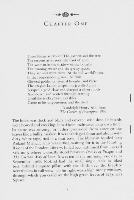
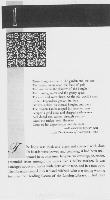
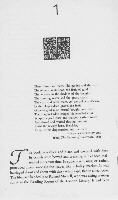
| In dealing with American editions of English authors, nothing can be taken for granted. Let me repeat: nothing can be taken for granted. (Weber 1952: 48) |
1. Publishing policies across the Atlantic
It is not unusual that English-reading audiences on either side of the Atlantic are being presented with individual editions of the same novel, and that these British and American editions may differ from each other. The fact that there are frequently at least two editions circulating, is a consequence of laws pertaining to the publishing sector. This is of course nothing new, but can be traced back to the nineteenth century, when the various national copyright laws not only opened the door to American piracies of British books, but also urged authors to spread their works in more than one legal edition to secure their royalties on both sides of the Atlantic. (See Weber 1952: 27-31; West 1990; 1992.)
A practical consequence of this necessarily multiple production process was that those involved in it - authors as well as publishers or printers - could introduce alterations, willingly or unwillingly, at particular stages. In the case of authors, this meant that they were offered the possibility to revise, and thus the chance to realize any second thoughts they might already have developed relating to what they had written only a short time ago (or third thoughts, rather, in case of a preceding serialization or any other form prior to book publication).1
In the case of publishers and printers, this usually meant (apart from attempts at outright censorship) that spelling and punctuation could be made to conform to either British or American practice or to any kind of publishing-house style, for example the alteration of '-is-' and '-our' (as in 'realise' and 'labour') to '-iz-' and '-or', respectively, or the change from single to double quotation marks as indication of direct speech.
These practices are still being observed today, even if some of the factors that initiated the multiple production process do no longer prevail. National copyright laws have given way to international copyright conventions, so that for instance the manufacturing of copies of a British novel within the USA is no longer prescribed as essential basis for US copyright protection.2 Another important change has been the increasing process of concentration within the book publishing sector, and the formation of transatlantic publishing 'empires' (frequently as parts of even larger multinational companies).
What has been said so far applies to A.S. Byatt's critically acclaimed and bestselling novel Possession, which tells the story of a contemporary pair of scholars investigating the mysterious relationship between two Victorian poets through their poems and letters. The British author's novel has been published and distributed by diverse branches of the US publishing company Random House, Inc. The first, British hardcover edition of 1990 came out with Chatto & Windus, Ltd. (London), followed up in the same year, after the novel had been reprinted several times and had been awarded the prestigious Booker Prize in Britain, by an American hardcover edition (Random House, New York). In 1991, paperback editions were published on both sides of the Atlantic, under the labels Vintage (London) and Vintage International (New York), respectively. The British editions are apparently stocked also by booksellers in Australia, New Zealand and South Africa; but not in Canada, where the US editions are circulating, too (through Random House of Canada, Toronto).3
Given these circumstances, and the possibilities of modern desktop publishing, nothing apparently could have been easier than to spread either facsimile reprints of the first edition (with no more than new covers, at most) throughout the whole English-speaking world, or to bring out American editions that vary from the rest only as to allow for different spelling and punctuation conventions. To proceed along either of these two lines would of course minimize production costs, and thus would increase the overall profit made by the various branches of the Random House group taken together.
Curiously, though, the production process(es) related to Possession have been distinctive, have apparently been motivated by clearly divergent policies, and have led to British and American editions that may have been published under the same label (Vintage Books, or, ultimately, Random House), but otherwise are clearly distinguishable. Possession - a novel dealing with textual scholarship (as one topic among others) - is therefore a good example to illustrate both modern publishing practice and recent editorial theories centering on the individuality of 'versions' rather than the uniqueness of a 'work'.
2. Variation
2.1 Bibliographical code
Textual variation between the diverse editions published by the Random House group relates to both the words on the page and to the presentation in book form, or, to take up Jerome J. McGann's distinction, it is both the 'linguistic' and the 'bibliographic codes' that differ in the various editions.4 In McGann's understanding, the bibliographic code comprises not only spelling, punctuation, and paragraph division, but everything related to the layout of the text, including cover, publisher's blurb and other forms of advertising. It is with the dissimilarity in the bibliographic coding of the novel's versions that I will begin.
It needs only a cursory look to recognize that there is a marked difference in how Possession is presented to British and to American readers. The British paperback edition follows in layout the first British, but not the intervening American hardcover edition. In consequence, American and British paperbacks vary, even though they are issued under the same label (Vintage Books). The different look of the text stems, for instance, from the way the headings and beginnings of the chapters are designed. The American editions are the more decorative ones, not only sporting a larger woodcut rather than a tiny vignette in the headlines, but also beginning chapters with a large initial. Thus, while the layout of the various editions of the novel altogether supports the juxtaposition of contemporary and Victorian elements within the story told, this collage is visually particularly prominent in the American editions. (This holds true even if the original design by Carole Lowenstein has been modified for the American paperback edition.) See the following facsimiles:
| (1) British pb. ed., p. 1 | (2) US hb. ed., p.3 | (3) US pb. ed., p. 3 |
 |  |  |
| see enlargement | see enlargement | see enlargement |
Other, prominent visual signs employed to underline the Victorian aspects within this contemporary 'romance' (as the subtitle has it), are of course the covers and titlepages of its editions. Once again, the American reader is now more strongly addressed in this matter. The photograph by Steve Wallace on the cover of the British paperback (which replaced the dustjacket designed for the British hardback edition) comes along in autumnal colours, but is otherwise temporally indistinct. The potential buyer of the American paperback, however, is directed back to both the Vicorian period and to the tradition of romance by way of a Pre-Raphaelite painting on the cover, namely "The Beguiling of Merlin" by Edward Burne-Jones (which had already been used for the dustjackets of both hardback editions). Instead of autumnal red and brown, the prominent colour in this case is gold. The only similarity between the covers of both popular editions is the montage of the novel's main title, in handwriting, onto the pictures. (Here again, the original American book design has been modified for the paperback edition. See examples 4 to 7.)
| (4) Brit. hb. ed. dustjacket | (5) Brit. pb. ed. cover and spine |
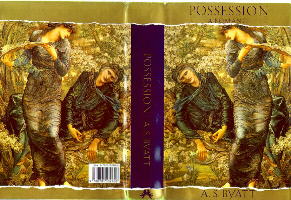 | 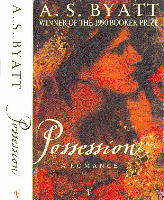 |
| see enlargement | see enlargement |
| (6) US hb. ed. dustjacket | (7) US pb. ed. cover and spine |
 | 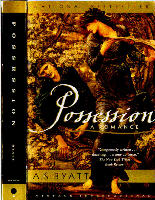 |
| see enlargement | see enlargement |
The browser in an American (but not in a British) bookshop will encounter the title logo four more times in the front pages of the paperback, i.e. on the fly-leaves, on the title-page (stretching over two pages) and immediately before the beginning of chapter 1. The 'romance' character is thus particularly stressed, as is the novel's title rather than the author's name. The potential American buyer and reader is meant to be attracted by the book on its own terms rather than as a further work by A.S. Byatt (which indirectly tells about the degree of her popularity in America then.)5
Yet, bibliographic codes on either side of the Atlantic do not only differ with regard to cover design, marketing features and overall layout, but also when related more immediately to the presentation of the words on the page that make up the story: to matters of spelling, that is, of punctuation, and of paragraph division.
Another, closer look at the beginning of chapter 1 (see the passages marked in examples 1 to 3) reveals variant punctuation that might have been caused either by authorial revision or by editorial collaboration.6 The latter is more probable, as the American editions have been progressively altered, whereas these alterations have not been taken over into the British paperback. While there are a few more occurrences of this sort in the American editions,7 the majority of punctuation changes is related to the American convention of consistently using double instead of single quotation marks, and thus falls into the category of layout as well.8 Seen on the whole, alteration of punctuation, while bearing the mark of additional labour by either author or editor, is neither excessive in general nor with a view on what is usually found in an American resetting.
Surprisingly, another and much more distinctive feature of editions reset in America - namely, spelling that differs from British usage - is absent from the American versions of Possession. Words like "favour" (A9), "vapour" (A163), "colour" (A358, A359, A469) or "rumour" (A526) are spelt in the British way, as are "compartmentalised" (A20), "glamorise" (A86), or "programme" (A431).
There are, to be sure, several instances where the interference of an American editor or printer is evident, particularly in the inconsistent spelling of "blond(e)". In both the British and the American editions, the spelling varies on several occasions between "blonde" (B504, A44) and "blond" (B15, B38, B74; A18, A83, A547), while the latter is both used in a masculine and feminine context.
Even so, British spelling on the whole has not been tampered with, albeit regularized.9 This is apparently to be explained with the publisher's estimate for a complete re-editing of the text, i.e. with production costs and time (and not with production technology, as these are problems that have regularly been dealt with by printing-houses in the past, and can easily be solved through modern desktop publishing).
Thus, in the end, the acute American reader of Possession is faced with an inconsistent and ambiguous appearance, even though Byatt's text has been dealt with once again (and partly altered) by another editor and printer in the USA. Despite the fact that the words of the text are now clothed in American punctuation, they still retain their original British 'characters'.10
Spelling and punctuation apart, there is nevertheless a remarkable dissimilarity between the bibliographically coded presentation of the story to British and to American readers. This has to do with paragraph division, i.e. with why and at what points within a chapter further segments of the narrative are distinguished, and how (and how clearly) this is signalled to the reader.
In the British editions, two general rules are being observed: first, direct speech by a character is usually treated as a paragraph of its own, and thus separated by a linebreak from the half-sentence that may precede it; and second, narrative segments within a chapter are signalled by an empty line. The latter device is being used very liberally, with the result that reading speed is thus considerably slowed down. A.S. Byatt has given the following reasons for this: "I try to stop the reader feeling my texts as dense, and to suggest a rhythm of reading, so I much prefer the English spacing" (Byatt 1996).
(My own reader may be reminded here of the way Henry Fielding had his narrator consider similar divisions as "inn or resting-place", necessary for a proper understanding, and also of the way Wolfgang Iser later defined these as 'Leerstellen', as empty spaces inviting the reader to establish the necessary narrative links for himself.)11
The American editions of Possession, on the other hand, have been designed for considerably faster reading. Direct speech, introduced by a half-sentence, has usually been incorporated into the preceding paragraph. Only a few empty-line divisions have been kept as such (and those only in the second half of the text).12 Others that have been kept received further visual emphasis by additional vignettes. Yet most of them have been scrapped completely, while new paragraphs, on the other hand, have been inserted only occasionally.13 The result is a presentation of the text that cuts down on the segmentation of the narrative, which is usually restricted to changes of location or focalisation,14 similar to the division of a play into scenes. The divisions kept are not only much fewer in number, but also made more prominent, and as the vignettes added for this purpose resemble those used for the chapter headings, the segmentation on the whole is made much more accessible, visually. This applies, too, for the way the "scraps of poems" at the end of chapter 19 are distinguished from one another. (For comparison, see examples 8 to 11.)
| (8) Brit. pb. ed. p. 418 | (9) US pb. ed. p. 452 |
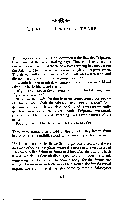 | 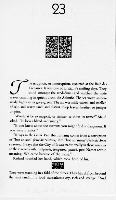 |
| see enlargement | see enlargement |
| (10) Brit. pb. ed. p. 381 | (11) US hb. ed. p. 412 |
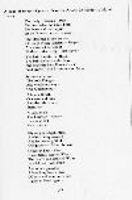 | 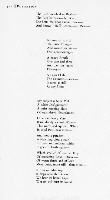 |
| see enlargement | see enlargement |
To summarize: though the various English-language editions of Possession seem at first glance to resemble each other, a closer look reveals a variety in the bibliographic coding of the text that already makes for a dissimilar reading experience.15 But it is not only the 'look' of these editions that has them appear as distinctly different versions of the same text - though it is one reason why I have dwelt so long on this part of their comparative textual analysis. (Another is that I think these aspects, whose importance has been duly stressed by for example Gérard Genette and Jerome J. McGann,16 are usually overlooked in the literary analysis and interpretation of texts.)
Appearances apart, there is indeed further proof that British and American readers are not being presented with the same text. Rather, as I said, they are reading distinctly different versions of it, a fact that is fully revealed when the respective linguistic codes of these versions - their 'texts', as it is commonly (and rather narrowly) understood - are brought into the analysis.17
2.2 Linguistic code
It is both in the bibliographic and in the linguistic code that the editions distributed in Britain (as well as in Australia, New Zealand, and South Africa) and those available in the USA (and in Canada) show textual variation. This comprises isolated allowances made for American English usage as well as the alteration of whole passages. Even if the latter and more significant category of revision is restricted to only a small number of examples, these are related to some rather crucial passages. In this, they are even more astonishing, as the fact that any revision took place at all is kept silent from the potential buyer and reader (who is, in other words, nowhere made aware that he or she has actually a choice which Possession he or she might like to succumb to).
Examples of isolated instances of lexical change - of the substitution of one word for another - are when a car "hooting" in the British editions becomes one "honking" in the American counterparts (B426/A461), or when a "towelling sweater" is changed into a "terry-cloth" one (B491/A532). These alterations were clearly made to account for the differences between British and American English usage (and in this regard correspond to the changes of punctuation mentioned above).
Other categories of stylistic and semantic context come in when a substitution takes place, for instance, to avoid either the repetition of a word, or stylistic inconsistencies, or the reader's possible misattribution of a pronoun.18
A third form of limited substitution occurs with regard to chronological errors. Richard Jenkyns, when he reviewed the first edition of Possession for The Times Literary Supplement, already pointed at
But it is only a similarly mistaken reference to "the Terror of 1799" in the first edition (B36) that has been set right, already so in later impressions and in all successive editions, to "the Terror of 1793" (Byatt 1990b: B36/A41), and also another slip of memory concerning "Wordsworth's Margaret in 'The Thorn'" (B422): beginning with the American hardcover, it correctly reads "Martha" (A457).
In general, it is not these factual errors that have been corrected, but those related to the fictional time-scheme of the story. Here, three stages of correction can be made out: those alterations that come in already with later impressions of the British hardcover edition, then others that were made later in the American hardcover (like the one just mentioned), and finally those that are evident in the paperback editions only.
Thus, in the first British version, Christabel is apparently born illegitimately, three years before her parents were married; while a second-stage change of date in the American hardcover version makes her a child born within marriage, and the elder one of two.20 Here, too, Christabel dictates her last will already on May 1st, not June 21st 1890 (A472/B435) - six weeks after her death (on May 8th 1890, B70/A79). That she dies at the age of 65, not 66, is a later change made for paperback readers that are given to check (B37/A42). Other such instances of third-stage alteration include Blanche Glover starting her journ!l on May 1st 1858, not 1853 (B43/A49), and the relationship between Randolph Ash and his wife Ellen. When they marry in 1848, he is now 34 - no longer 30 -, and she is 36, respectively - neither 32, nor 34 (as the hardcover editions had it at different times: B110/A122, B460/A499). At the time of his death in 1889, both can of course have been married for only "-ore than 40", and not for "more than 45 years"; or to be exact: only for 41, not for 44˙years (as the hardcover editions had it both times, B444, 449/A483, 487).
The circumstances of Ellen Ash's life, finally, have been subject to correction in all three stages: first, her maiden name could not plausibly have been Ash, and therefore was changed to Best already in later impressions of the British hardcover original (Byatt 1990b: B109). And as she was to die seven years after her husband, this could of course not have occurred in 1893 but only in 1896 (second-stage correction in the American hardcover, A484/B445). The return to the 1893 date in both paperback editions then (in a third stage of correction) made the alteration to a four-year interval between the couple's deaths necessary (B444-45/A483-84). All these alterations prove that the fictional time-scheme has clearly been checked thoroughly, and several times.
Altogether, the three forms of substitution mentioned, albeit for various reasons, equally bear the mark of rigorous editorial copy-reading, and arguably lead to a better understanding of the text. In this regard, it is deplorable that most of them have not been been taken over from the American hardcover edition, in which many of them were first introduced, into the British paperback edition published a year later. It is only the last category (correction of internal chronology) that has indeed been introduced into the British paperback edition, which follows, in all other respects, later impressions of the first British, but not the intervening American hardcover edition.21 The British paperback turns out to be a corrected reprint of its predecessor this side of the Atlantic, while its American counterpart under the Vintage label reprints the already corrected American hardcover version (albeit with modified layout as to chapter headings and initials).22
While this holds true, the situation is generally different for those instances when longer passages, not only words in isolation, have been altered: that is, when not only limited, but extended revision has taken place. For once, it is of course much more difficult for a critic to detect in retrospect who (editor again? or author? or publisher?) urged revisions on whom in this case, and why at all. Adding to this is the critic's usual problem of assessing the impact of revisions, both in the light of how they stand to other versions of the text and in their effect on the reader.
To begin with a rather marginal example: When, towards the end of the story, most of the characters meet for a business dinner, the first-edition reading "Roland had never tasted pheasant" (B433) is - in the sixth impression of the same year, at the latest - changed to "Roland found his pheasant tough". Revision in this case is most certainly due to an authorial afterthought, and has been observed in the American hardcover and in all later editions (A470).
All in all, there are another four substantial instances of revision evident (on closer inspection) in the American versions of Possession, and they are both more relevant and less easily attributed to authorial discontent alone. Most of them are to be found in chapter 2, and altogether, they cover three possible ways of revision, namely textual addition, deletion, and substitution (rewriting). Deletion takes place, for instance, when the garden is described which lies outside the flat that Roland and Val share. The English editions read:
The historical digression, and thus the whole sense of the passage, is withheld from the American reader, who is only being presented with a
An instance, when addition of text can be discerned, is found in chapter 13. Here it is the English editions, who have Roland go to sleep swiftly in the Hoff Lunn Spout hotel:
An American reader, meanwhile, finds Roland in this situation engaged in a much more extended experience:
Although Byatt herself was not happy with the alteration (see below), I myself think that this Roland here is clearly more sensitive to the situation, and that this passage is much stronger integrated into the whole narrative than the preceding version.
But the two most interesting, and most crucial, cases of revision are related to the initial presentation of two of the main characters, namely Roland and Randolph Henry Ash. Both examples of revision occur in chapter 2; the first, concerning Roland, is again a case of textual addition or expansion. This is the British version:
And this is the version of Roland presented to an American audience:
American readers are obviously introduced, via narrator's commentary, to a much 'rounder' picture of the man, a characterization which not only takes in his outward appearance, but also his behaviour and its effect on others.
In the variant case of Randolph Henry Ash's first extended intr/duction to the rea$er, not only expansion, but the rewriting of the whole passage occurs. The description of his appearance is achieved by having Roland look at reproductions of contemporary portraits hanging on the walls of his and Val's flat. Then, Roland's thoughts are given:
So much for readers of the British editions. American readers, meanwhile, get this impression:
Once again, as in the case of Roland Michell, the impression is a much more visual one, and one that centers not only on appearance but also on the effect on others. But here, the passage is also stylistically heightened and in consequence may be much more memorable.
As I said before, the latter examples of revision and variation relate to the first extended description of Roland Michell and of Randolph Henry Ash, and therefore are of decisive importance in forming the reader's mental image of them. It will be interesting to see how these central characters may come across when the novel has been filmed, and to see if the British or the American version of the nove, was made the basis of script and casting.
3. Some explanations
By the analysis of the textual variation between the diverse editions of Possession, it (as hopefully become clear why at least some of the alterations related to layout and text of Possession have been introduced. But who was finally responsible for these? I have put the question to A.S. Byatt.
Altogether, three publisher's readers were involved in editing A.S. Byatt's manuscript - two successively for the British, and one for the American editions ('copy-editors' not included).24 As has been shown in detail, their conceptions of how the novel should address exactly what readership clearly differed, and that is certainly one of the reasons why Random House UK, for their paperback edition, stuck to layout and text of the novel as it had been produced in Britain before.
As a matter of fact, the various publishing companies within the Random House group do not necessarily have to cooperate fully in a case of transatlantic publication.
In the case of Possession, the British and American companies indeed went their own ways, as Byatt's following statements on the production history of the novel demonstrate:
I agreed to expand on Roland's thoughts27 as an act of self-destructive desperation, not because I thought it improved things - I thought it was redundant and nonsensical - but because I am naturally good mannered and it was the only one of the editorial suggestions I felt even partly capable of accepting. That was one of the places (as I remember) where the editor had made the comment that I had missed a good opporunity for a climax, which I don't think she even saw was ambiguous or funny. (Byatt 1997)
They printed ca 7000 and sold ca 110000, largely because readers liked the book, wch makes it into a kind of editorial fairy story. In defence of the editor, it must be said that she was the only one prepared to take on the book at all in the US.
[...] I am sure the quotes are more or less exact - they are burned on my memory. (Byatt 1996)
Clearly, Antonia Byatt's publishers and commercial editors (from within the same publishing group) have made a distinction between readers and reading habits in Britain and in America, and if given the chance, did not refrain from altering texts to suit different audiences. This has held true of the changes involved with the first American, hardcover edition of Possession, as it has when these changes later on were not taken over into the popular (second) British edition in paperback form. With regard to the status of the author, the commercial standing of the publishing group, and the critical and commercial success of the novel, the fate of Possession appears to be less an isolated case history than rather a typical example of what is going on in parallel transatlantic publication today (from which apparently only successful authors - Booker Prize winners, for instance - are exempted). It is an example that can in many ways be fairly generalized.
4. Some generalizations
Even if Byatt's novel contains a sideswipe at "Market Forces" in areas of culture (B398-99/A431), it would of course be naïve to deny their influence on the way literature is produced, distributed, and read. Does this mean, in consequence, that any novel-in-the-making does automatically, if gradually, pass over from being an author's possession to become the publisher's, or publisher's editor's one? - Not surprisingly, A.S. Byatt has uphold the author's prerogative (with a pointedness against American editors in general):
Byatt's view, here, on the merits of the various versions of her own novel is consistent with the stance she took as a scholarly (not commercial) editor herself. When she prepared The Mill on the Floss for the Penguin English Library in 1979, she tried to work back as near as possible to what George Eliot wrote down, and to erase from 'her' text all those alterations made in the printing-house (see Byatt 1979: 659-61).
Another connection between these two writers can be made. George Eliot then was still in the early years of her career as a novelist, and this is one reason why her publisher could exert a greater influence, and leave a mark on the version of her text that was finally available from the bookshops. Though A.S. Byatt is a much more mature writer, the different degree of her popularity (or, seen with a publisher's eye, marketability) in Britain and in the USA at the time of publication of Possession comes in here, too. Byatt was evidently powerful enough to exert a comparatively great control over the versions of her text made available to British readers, but she was clearly less influential when dealing with the American branches of the Random House group. It is just the critical and commercial success of Possession that by now has swung the balance into her favour, everywhere: "other editors now hesitate to interfere with my work", Byatt says herself (1997). It is less likely, therefore, that British and American versions of her works after Possession will show the same degree of variation. (So far, they are still being produced by members of the same group.)
Yet, what has happened to Possession then does not only affect this particular text in its still available versions and their present reception, and it is not just a very instructing example of how transatlantic production and distribution of 'English' literature in general is happening today. The example of Possession shows, too, how fruitful a text and its history can be analysed by literary scholars, when they do not only take 'literary theory' (narrowly conceived), but also recent editorial theory into account.
Over the last three decades, theorists in this field have developed an outlook on changes made to a text during its publication history that is now incongruous with, for instance, the one Carl J. Weber took at the beginning of the 1950s. He followed up the admonition quoted in the motto to my article with further pieces of advice:
Not only because of its anti-American overtones, this is a very biased view, yet not an uncommon one. When it is simplified to the point that later editions not overseen by an author can do only harm to his or her text, Weber's view may be taken as an example for the Greg/Bowers school of editing (named after its leading proponents, W.W. Greg and Fredson Bowers).
This approach, directed at authorial intentions alone, has been countered in recent years by theorists that regard texts as outcome of a collaborative effort by more than just their authors, and as a product that has been presented to different audiences in different historical situations. Consequently, rat(er than conceiving literary texts as unique stable entities - as 'works' -, many theorists now point to the diverseness of textual 'versions', to all of which they grant equal status.29
Applied to A.S. Byatt's Possession, this view would consequently see both its British and its American editions as legitimate (and not merely as co-existing) versions. They were produced, i.e. created and prepared for book publication, by various teams, all of which included the author - willingly or unwillingly. As her intentions carried different weight at different times, other considerations, by other members of the team, could come in and leave their mark in the individual processes of production. This in consequence led to the publication of variant versions of Possession, meant for and presented to specific audiences within the English-speaking world. (This process of spreading versions continued, by the way, when two interpolated narratives from Possession - "The Glass Coffin" in chap. 4 and Gode's tale in chap. 19 - were later on separately published in a collection of fairy tales by the author: see Byatt 1994.)
With hindsight, it is not the first, British hardcover edition - the version of Possession that was awarded the Booker Prize - that appears to agree most with authorial intentions, but the successive British popular edition. If already this reprint with corrections bears the mark of additional editorial labour, it is the American editions that come across as a clearly collaborative product. They are the result of a compromise that was finally reached between authorial intentions with regard to the text, and publisher's (or publisher's editor's) assumptions with regard to the expectations of an American reading public.
Though not participating in either the author's originary creative effort, nor ever rivalling Byatt's degree of control over the text that became its result, the American publisher's editor nevertheless was finally responsible for a new look of the text, and in part for new text in the book.
Did the American editor really do some harm in the process, as the embittered author feels? Seen without Byatt's understandably personal bias, and without regard to the notion of the equality of all published versions, the American paperback's bibliographic code is arguably more reasonable, consistent, and attractive, than the 'British' presentation of the text. Any judgment on the reworking of the text itself (the linguistic code), meanwhile, remains to my mind simply a matter of taste - and not, as the author sees it, one of principle.
In short: A.S. Byatt's text began to mean different things to different people, when it first ceased to be her possession alone, long before it was finally seized by her readers.
Texts
Byatt, A.S. (1990a): Possession: A Romance. London: Chatto & Windus.
--- (1990b): Possession: A Romance. 6th impression London: Chatto & Windus.
--- (1990c): Possession: A Romance. New York: Random House.
--- (1991a): Possession: A Romance. London: Vintage.
--- (1991b): Possession: A Romance. New York: Vintage International.
--- (1993): Besessen, transl. by Melanie Walz. Frankfurt a.M.: Insel, 1993, repr. 41993. Paperback repr. Frankfurt a.M.: Suhrkamp, 1994, repr. 1996.
--- (1994): The Djinn in the Nightingale's Eye. London.
References
Bruccoli, Matthew J. (1969): "Some Transatlantic Texts: West to East". In: Bibliography and Textual Criticism: English and American Literature, 1700 to the Present, ed. O.M. Brack and Warner Barnes. Chicago, 244-55.
Byatt, A.S. (1979): "A Note on the Text". George Eliot, The Mill on the Floss, ed. A.˙S. Byatt. Harmondsworth, 659-61.
--- (1996): Letter to Helge Nowak (4 October 1996).
--- (1997): Letter to Helge Nowak (21 March 1997).
Genette, Gérard (1983): Nouveau discours du récit. Paris.
--- (1987): Seuils. Paris.
Iser, Wolfgang (1970): Die Appellstruktur der Texte: Unbestimmtheit als Wirkungsbedingung literarischer Prosa. Konstanz.
--- (1976): Der Akt des Lesens: Theorie ästhetischer Wirkung. München.
Jenkyns, Richard (1990): "Disinterring buried lives". In: The Times Literary Supplement 2 March, 213-14.
Mackinnon, Frank and Kenneth Ewart (1985): "Notes on the History of English Copyright". In: The Oxford Companion to English Literature, ed. Margaret Drabble. 5th ed. Oxford, 1113-25.
McGann, Jerome J. (1983): A Critique of Modern Textual Criticism. Chica'o.
--- (1991): The Textual Condition. Princeton, N.J.
--- (1993): Black Riders: The Visible Language of Modernism. Princeton, N.J.
Moser, Thomas C. (1996): "Textual History". In: Joseph Conrad, Lord Jim, ed. T.C. Moser (Norton Critical Edition). 2nd ed. New York, 247-51.
Uglow, Jenny (1997): Letter to Helge Nowak (26 February 1997).
Walz, Melanie (1993): Letter to A.S. Byatt (19 January 1993).
Weber, Carl J. (1952): "American Editions of English Authors". In: Nineteenth-Century English Books: Some Problems in Bibliography, by Gordon N. Ray et al. Urbana, Ill., 27-50.
West, James L. (1990): "Book-Publishing 1835-1900: The Anglo-American Connection". In: Papers of the Bibliographical Society of America 84, 357-75.
--- (1992): "The Chace Act and Anglo-American Literary Relations". In: Studies in Bibliography 45, 303-11.
Zeller, Hans (1975): "A New Approach to the Critical Constitution of Literary Texts". In: Studies in Bibliography 28, 231-64.
Notes
1 One instructive example is the transatlantic history of the publication (and revision) of Joseph Conrad's Lord Jim. For a summary account of it, cf. Moser (1996: 247-51).
2 This condition was introduced into US copyright law in 1891, and governed the publication of British literature in the USA up to 1957. Cf. Mackinnon and Ewart (1985: 1123) and also West (1990; 1992).
3 As indicated on the copyright pages of the paperback editions mentioned. In quotations from the editions, the letters B or A before page numbers refer to either the British or the American editions (both in hardcover and in paperback). When two page numbers are given in combination, the first is that of the edition quoted from, the second that of the companion referred to for comparison.
4 Cf. McGann (1991: 13, 52, 60-67; 1993). Cf. also the independent and extended analysis of elements of the bibliographic code, as 'thresholds' in the reader's encounter of the text, in Seuils (Genette 1987).
5 The author's name is significantly much less conspicuous on the spine and frontcover of the American paperback than on its British counterpart, and it is completely absent from both the publisher's blurb and the review excerpts on the backcover of the American paperback. While the British paperback has a biographical sketch right at the beginning (on the fly-leaf), its counterpart in the American edition is much less detailed and relegated to the back of the book. Instead, the front matter of the American paperback consists of two pages of review excerpts from American magazines, which only occasionaly refer to the author.
6 For the aspect of collaboration, cf. McGann (1983: 42-48; 1991: 60-61), amongst others.
7 Another example of commas added is "How many, many" (A308/B283, twice).
8 Apart from this general procedure, there are a few instances where quotation marks have been added. See, for example, "An odd phrase", "by heart," (A30/B26). Yet there are also other examples where these marks have been mistakenly left out (i.e. at the end of the last poem quoted in the novel, A554).
9 An example for regularization is the spelling of the interjection "Uh-huh" (A347, A354, B326; but "Uh h-huh", B320). Another attempt at consistency is the reference to "[t]he Rowan Tree" (A526, 529, 539; B487, 496) rather than to "The Old Rowan Tree" pub (B484). Capitalization has also been regularized (cf. "a personification of history", A6/B3; "We played chess", A251/B231; "book on harmony and discord", A337/B311), and has sometimes been added when necessary (cf. "Death Be Not Proud", A483/B446; "Witch in a Turret", A490/B451).
Apart from this, some obvious misprints in the British editions have been corrected: "Principj" (B2/A4), "come to this?" (B218/A238). A new typographic error, though, is "Mille de Kercoz" (A340).
10 West's observation, made with reference to the beginning of the twentieth century, that "American readers, as a rule, seem not to have been particularly sensitive to British orthography and usage. [...] The reverse, however, was not true", may thus still be shared by Byatt's publisher at the end of the century (West 1992: 307; see also 308).
11 Cf. Fielding, Joseph Andrews (1742), II.1 ("Of divisions in authors", i.e. of novels into 'books' and chapters). Cf. Iser (1970; 1976).
12 Cf. A353-54, 369-94, 416, 453-67, 484-502, 512-514, 527, 541.
13 Cf. A38/B33, A164/B148, A176/B160, A515/B474.
14 Gérard Genette's term for, roughly speaking, how and how much information is presented to the reader (1983: chap. 12).
15 The last remark holds true for translations, too. The German version (Byatt 1993) generally follows the 'British' bibliographic code within covers: in sticking to that one's paragraph division, for example, or in its abstention from the use of additional vignettes. (Indeed, vignettes are not used at all, not even in the chapter headings, so that the layout looks less 'Victorian' to German readers.)
16 See note 4, above.
17 To avoid misunderstandings, I have hitherto in this article used 'text' in the traditional sense, too, roughly meaning the words the author wrote.
18 Thus, in the passage "Maud wondered, and decided almost inevitably not", "necessarily" stands in for the word "inevitably" that is repeated already in the next sentence (B250-51/A273). Furthermore, the inconsistent use of either French or English headings for the entries in Sabine's journal have been regularized to English ones, starting with later impressions of the British hardback edition (B346-73/A375-403). Finally, after a conversation between Maud Bailey and Beatrice Nest, "[s]he" makes way for "Maud" in the American editions, to avoid a reader's misunderstanding (B235/A255).
19 Jenkyns (1990: 213). The reference to Silas Marner occurs in chap. 19 (B341/A370).
20 The dates given (B36/A41) are 1825 for Christabel's birth (in all editions) and either 1828 (British hardcover and American paperback) or 1823 (American hardcover and British paperback) for the marriage of her parents. This example is an exception in that in all other respective changes, both paperback editions collectively agree against the first edition (in all its impressions of 1990). The fact that a 'resetting' took place at the last moment, in this instance as in the reference to the Terreur, is clearly visible in the British paperback. As her sister's birth occurred in 1830 (B36/A41), the inscription on Christabel's tombstone (from the American hardcover onwards) shows her to be the "[e]lder daughter" (A79/B70).
21 Reference is still - wrongly - being made to "the forests of Paimpol and Brocéliande" in Brittany, for instance (B335, 339), when it should read Paimpont instead (A363, 367).
22 The rigorous German translation by Melanie Walz (see note 15, above) generally follows the British paperback version. The exceptions to the rule, nevertheless, mark it as another corrected version. Apart from placing the Terreur in 1794 (Byatt 1993: 51), Walz introduced even more corrections into her translation:
Emilie de Kercoz, [Jean-] Baptiste [..] LaMotte's wife, is the elder sister of Benoît, who is Raoul's father [B341]; therefore, on page 36 ([British] hardcover edition) it must be Benoît and not Raoul;
on page 313 are mentioned (in Ariane's first letter) four unpublished novels by Sabine, while on page 380 (in the second letter) it is said: "She published the three novels mentioned above"; in the German version, I changed both allusions to: three published novels, one (La Deuxième Dahud) unpublished (Walz 1993, with my addenda).
While former queries of the translator had initiated the changes made to the internal chronology, these corrections here were not taken over into later British or American impressions.
23 Byatt (1996). "Line-editing" means a thorough re-editing, 'line per line'. I am very thankful for this and other information that I received fro- A.S. Byatt, from her English editor Jenny Uglow, and from her translator Melanie Walz, in letters and during the British Council's Walberberg Seminar (23-26 January 1997). To my regret, the American branch of Random House did not answer my respective queries, so I am unable to offer their view of what happened.
24 The normal procedure [at Chatto & Windus (HN)] is as follows:
Typescripts are read by the editor, who may (or may not) make suggestions. These can be about major things such as structure, timing, character, plot, or details - anachronisms - or style. These are discussed with the author, and if necessary the ts is revised; [...]. Before the final draft goes to the printer it is copy-edited by an outside copy-editor - who gives a final careful check for punctuation, consistency of names, details, dates, spelling, as well as marking it up for the printer. (Uglow 1997)
25 B11/A14, quoted above.
26 For 'paper-round', cf. B11/A14.
27 B243/A264-65, quoted above.
28 Weber (1952: 50). This apparently applies also to texts travelling in the opposite direction: For a closer look at American editions of British authors, cf. Bruccoli (1969).
29 Though in both cases the ideas do not originate with them, the name foremost associated with a 'social' or socio-historical approach within editorial theory is that of Jerome J. McGann, and the concept of 'version' has been presented to an Anglo-American audience by Hans Zeller (1975). My habilitation thesis (in progress) will include a summary treatment of these approaches at a definition, of various distinctions between 'text' and 'version' (or between 'texts of works' and 'texts of documents'), and of recent developments in editorial theory in general that are of interest to literary scholars not involved in editing.